 |
Compressed Air Trams
By John Prentice |
 |
Compressed Air Trams
By John Prentice |
With the approach of the great 1889 exhibition, the Paris tramways looked to build new lines with mechanical traction. The CFN on 21st August 1887 opened their 11.6 km. route from Vincennes to Ville-Evrard via Pont de Mulhouse and La Maltournée. This used Mékarski double deck cars, which in busy times could pull one or even two trailers. The line proved most successful as not only was there commuter traffic, but also a good Sunday trade as Parisians like to visit the Bois de Vincennes.
The initial route was extended on 27th December 1888 with a branch from Nogent-sur-Marne (Pont de Mulhouse) to Bry-sur-Marne, and a second branch on 1st December 1894 from La Maltournée to Rosny-sous-Bois.
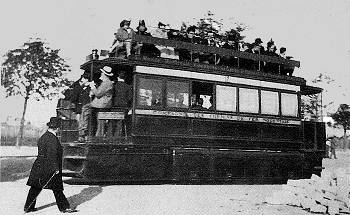 An early Mékarski open-top car on Chemin de Fer Nogentais.
An early Mékarski open-top car on Chemin de Fer Nogentais.
The trams had 4-whee1 1.90 metre wheelbase trucks (1.90 was an early standard for Paris cars) and were single ended and quite asymmetrical, being turned at termini. The rear platform had stairs to the upper deck which was open top with knifeboard seats. They were 7.53 metres long and weighed 10 tons unladen, carrying 50 passengers (20 inside, 6 on platform, 24 on top). There were 19 of them numbered 1-19.
Air was carried on the cars in nine reservoir cylinders under the cars parallel to the axles, each 0.6 metres diameter giving a total of 3,100 litres of air at 45 atmospheres. This was split between 6 main cylinders holding 2,030 litres and three reserve ones holding 1,070 litres. The bouillotte held 200 litres of hot water at 155 degrees centigrade and the regulator supplied air to the driving cylinders at up to 6 atmospheres.
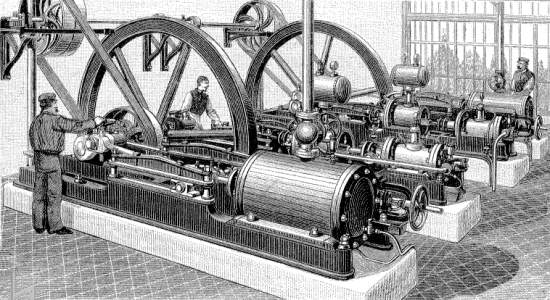
The compressor set was installed at Maltournée depot where there was a charge point. Two boilers fed two 55 horsepower steam engines which were connected by line shaft to two compressors. Each compressor had low and high pressure cylinders delivering air compressed to 6 and 45 kg respectively. The air was then stored in twelve reservoirs. Extra charge points were at Vincennes and Bry-sur-Marne, fed from Maltournée. All three charge points had their own steam generators to reheat the water in the bouillotte. This was done by a jet of steam and each charge took 15 minutes. The air consumption was said to be 10 kg per car kilometre.
Despite difficult gradients these cars performed well carrying 630,000 passengers in 1888 rising to 1,286,000 by 1890. In the first year of operation the car receipts were 170,000 francs at a cost of 122,000 francs.
In 1900 the trams were replaced by electric cars, the last Mékarski car running on the Rosny Branch on 1st November 1900.
The TSM operated routes with Mékarski cars as follows: Charenton to La Varenne opened 19/3/94, Saint-Maur to Joinville opened 26/7/95 and extended to Vincennes 6/1/97 and Joinville to Champigny opened 24/4/98.
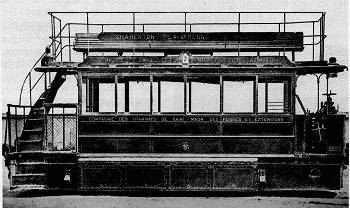 Mékarski car on the Saint-Maur tramway in 1894.
Mékarski car on the Saint-Maur tramway in 1894.
The compressor and charge point was at the depot at Saint-Maur. The trams were very similar to those of CFN being open top because of low bridges of the Chemin de Fer Vincennes which crossed the tramway. There were ten cars numbered 1-10 each seating 49. The full specification is not known.
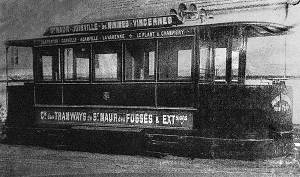 One of the short-lived Popp-Conti cars of the TSM's Champigny line in 1898.
One of the short-lived Popp-Conti cars of the TSM's Champigny line in 1898.
For the Champigny line four small single deck cars of the Popp-Conti low pressure system (see below) were tried. The performance of these cars, like all low pressure cars, was extremely poor and they were soon replaced by spare Mékarski cars from the other lines.
All the compressed air cars were withdrawn in 1900.
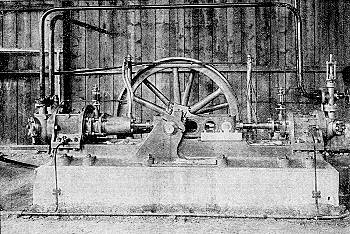 The compressor set as used on a typical Popp-Conti system.
The compressor set as used on a typical Popp-Conti system.
The Popp-Conti low pressure system, based on designs by Victor Popp and James Conti, was first demonstrated in 1894 on a test track in Champs de Mars, and was then used for a short time by TSM and the tramway at Saint Quentin. Popp already supplied compressed air via a network of mains to industries in Paris, so this system was a natural extension to his business.
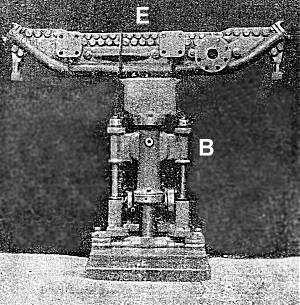 Removed connector equipment used to supply air from the underground main to the tram. E is the shoe that would be fitted to the tram. B is the cylinder and a connector pipe which was raised from the ground.
Removed connector equipment used to supply air from the underground main to the tram. E is the shoe that would be fitted to the tram. B is the cylinder and a connector pipe which was raised from the ground.
The car's reservoirs (A on the drawing below) were charged at 15 to 20 atmospheres only, but charging was done at each tram stop, or about every mile and a half. An underground pipe laid parallel to the tram tracks had feeders to a distribution point between the rails at the tram stop. This distribution point had a small cover plate (C) made of bituminized cast iron, laid flush with the street. When the front wheel of a tram contacted a treadle (D) in the track groove, a valve allowed air to pass into the feeder pipe, which in turn caused a cylinder below the distribution point (B) to push up a connector pipe between the tracks and engage it with a longitudinal shoe (E) under the car. A seal was kept by two rubber lips fitted to the shoe, which were inflated by the air pressure from the car's reservoir. Once the tram moved away the connector pipe retracted.
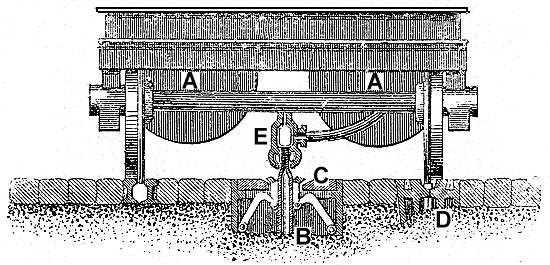
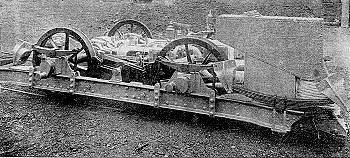 The 4-wheel truck used on Popp-Conti trams. Note the hot coke hopper at the right end.
The 4-wheel truck used on Popp-Conti trams. Note the hot coke hopper at the right end.
The cars were mounted on a 4-wheel truck with cast steel side frames, sprung to the body by leaf springs. The axles were sprung by leaf springs to the side frames. The axles were coupled. Between the frames there were two compound cylinders, but valves allowed air to be applied directly to each if required.
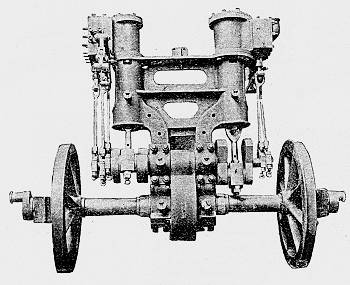 The cylinders and one axle from a Popp-Conti tram.
The cylinders and one axle from a Popp-Conti tram.
The cylinders were connected to a crank shaft which was geared to one of the axles, gears being enclosed in an oil filled casing. At one end there was a hopper which contained a coke fire, which was filled once per day and which heated the air in passing from the reservoirs to the cylinders.
Low pressure systems such as the Popp-Conti were far less successful than high pressure compressed air trams like Mékarski, and did not last long.
In 1893 the CGO decided to substitute mechanical traction instead of horses on the routes of Versailles, Sèvres and Saint-Cloud. Mékarski locos were used but not without difficulty. They began service on 17/6/94 between Louvre and Saint-Cloud and then the next year on Louvre to Versailles, but due to loco exhaust freezing and blocking air lines, horse traction had to be put back from 4/5/95. The problem disappeared in the Spring and later Mékarski modified the air distribution. It was not until 6/10/96 that the last horse pulled car ran. These routes were designated TA and TAB respectively, with short workings run by Rowan steam cars.
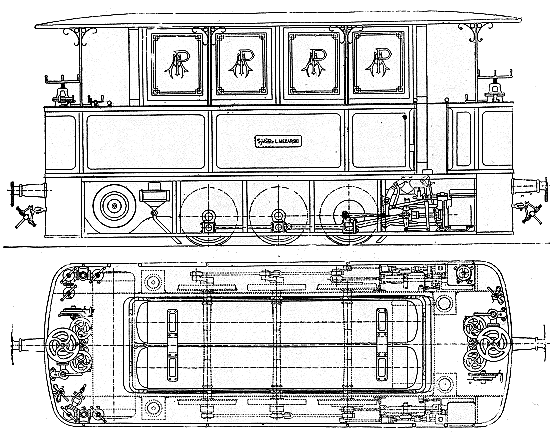
From 1895 locos of the same type were used to pull trailers from Porte d'Orléans to Odéon, on the line of the Paris-Arpajon tramways. This was a steam tramway pulling trams of at least four single and double deck trailers. As their locomotives were unsuitable for use over the city tracks, Mékarski locos were substituted at Porte d'Orléans. As the length of trains over the city area was 35m maximum, the train split into two sections, each of two or three cars with each car having a brakeman.
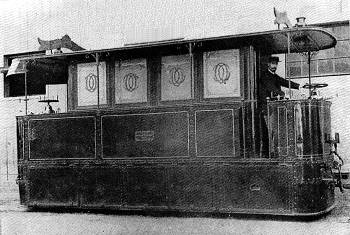 Mékarski locomotive of 1894 in the livery of the CGO.
Mékarski locomotive of 1894 in the livery of the CGO.
The locos were enclosed 0-6-0 with 0.9m axle centres. They were 6.55m long. 2.12m wide and 3m high weighing 16.5 ton empty and 18 ton in working order. They were double ended. The driving cylinders were mounted under one platform outside the frames and driving the axles via connecting rods. Walschaert's valve gear was used. Braking was also by compressed air at six atmospheres. Air was stored in 8 reservoirs of 60cm diameter and 3.6m long, placed longitudinally in four rows. They held 530 kg of compressed air at 80 atmospheres. Hot water was stored not in a "bouillotte", but in cylinders under the platforms at each end, one of 300 litres, the other a 175 litre reserve. They were recharged by a steam jet.
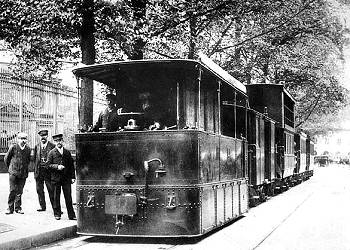 PA Mékarski locomotive seen the Luxembourg terminus at Place de Médicis in 1895.
PA Mékarski locomotive seen the Luxembourg terminus at Place de Médicis in 1895.
For the CGO, the compressor set was at their works at 136 Avenue de 'a Reine, Boulogne. Mains fed the high pressure air to charge points at Point de Jour depot, 226 Avenue de Versailles and Sèvres depot, 169 Grand Rue. Both these points had their own steam generators. At a later stage a point was installed at Place de l'Alma fed from the Billancourt air plant. The PA compressor was at that company's Montrouge depot. CGO normally had 12 locos in service pulling two or three trailers each. CGO owned 23 of these locos and PA had 5.
The PA locos were replaced by accumulator cars on 15/11/1901. Those of CGO on route TAB ceased operation on 12/7/07, but of the CGO locos, 12 had been converted to the Purrey steam system.
From 17/8/1906 the line from Versailles to the city boundary at Saint-Cloud was electrified using overhead wire and 16 former accumulator trams with their batteries removed and a pole added. These cars were then towed, with their trailers, over the non-electrified city area tracks to Louvre using the Mékarski locos as previously used on this route.
It was soon found that the locos did not have enough power, so twelve of them were converted to the Purrey steam system coming into service in June and July 1907 with the last air car running on 12th July.
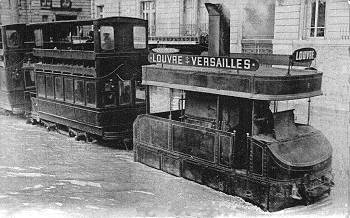 Mékarski locomotive number 9 as converted to the Purrey steam system, pulling two trailers during the Seine floods of January 1910.
Mékarski locomotive number 9 as converted to the Purrey steam system, pulling two trailers during the Seine floods of January 1910.
The Purrey locos used the original Mékarski truck but the centre axle of the 0-6-0 units was removed to give an 0-4-0 of 1.8 metre wheelbase. They were numbered 1-12 and were 6.55 metres long, 2.12 metres wide and 4.70 metres high (over the chimney). They weighed 11.5 tons empty and were symmetrical, with a driving position at each end.
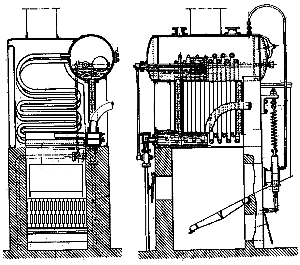 A drawing of the Purrey steam generator, taken from the 1898 British patent of the device.
A drawing of the Purrey steam generator, taken from the 1898 British patent of the device.
The Purrey steam generator had 19.69 square metres of heating surface with water supplied by two donkey engines. The generator was fitted to the centre of the locos, from where the air reservoirs had been removed, and had a square chimney which came out through the roof, which itself had been given a small skirt. Steam was fed to the original two Mékarski driving cylinders which drove one axle, both axles being joined by coupling rods.
The hot water cylinders were obviously no longer required and the tram-like front dash panels were replaced by a sloping front. Braking was still carried out by compressed air, held in a reservoir at 80 kg/sq. cm. reduced to 6 kg/sq. cm. for use. As the locos carried no compressors, it is assumed that the reservoir was recharged at the air Points at Alma and Point du Jour still used by route TA.
The last of these Purrey/Mékarski locos was used on 1/10/1913 after which the overhead was extended to near Trocadero, and from there to Louvre centre conduit was laid.
![]() Go now to Next Section
Go now to Next Section
![]() Return to Index
Return to Index